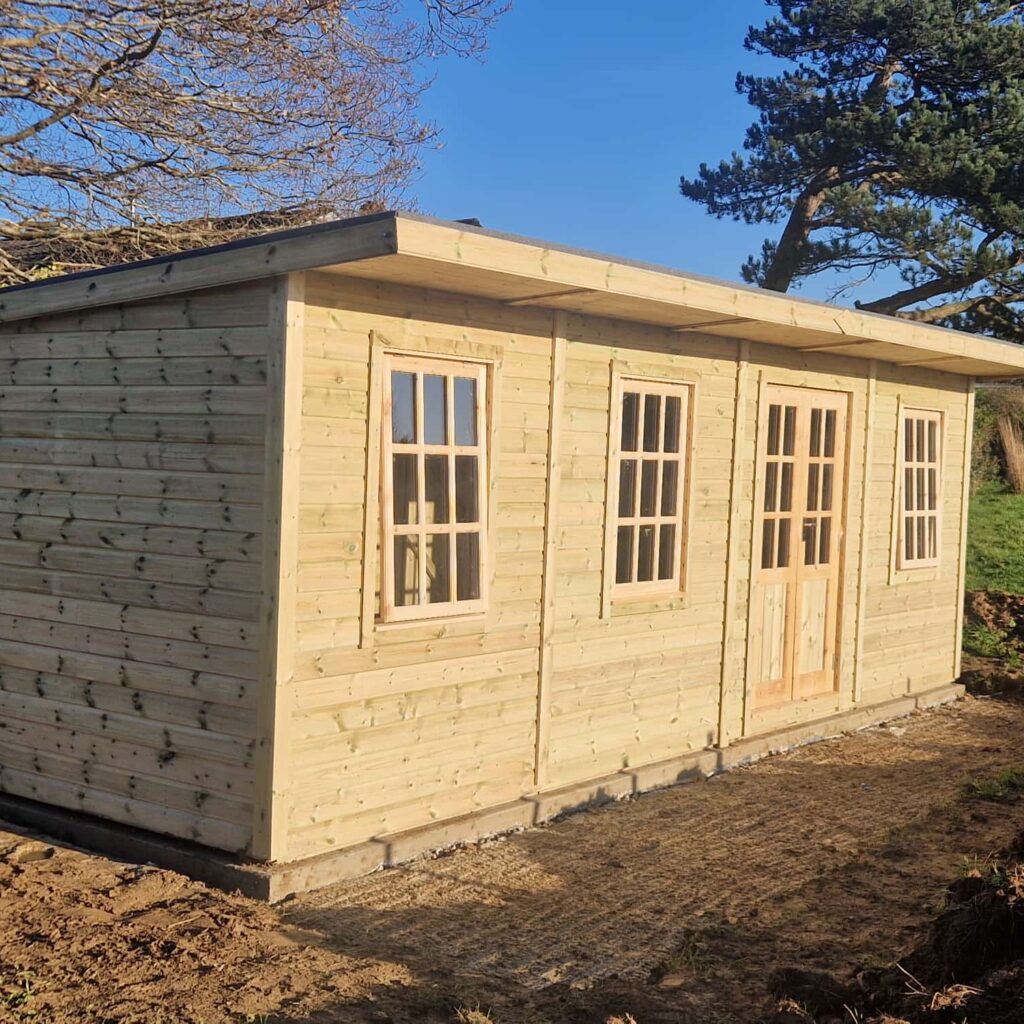As the leaves turn and the evenings draw in, the classic British autumn brings a predictable companion — rain, and plenty of it. If you own a timber summerhouse, this is the season when maintenance becomes essential. Regular upkeep helps protect your investment from rot, mould, and water damage. Whether your building is used for storage, relaxation, or a home office, taking steps to maintain your summerhouse through autumn will keep it looking great and functioning well for years to come.
Let’s explore the practical steps you can take to defend your garden retreat against the wet weather, from exterior treatments and guttering to interior protection and airflow.
Keep the Rain Out: Focus on Roof and Gutter Maintenance
The first line of defence against autumn rain is your summerhouse roof. Before the wetter months fully set in, carry out a full inspection for any signs of wear. Look for loose felt, exposed timber, sagging panels, or cracked shingles. If your summerhouse uses EPDM rubber or a corrugated metal roof, check for any movement at the edges or signs of pooling water.
Once the roof is in good shape, attention should turn to guttering. Adding gutters to your summerhouse may seem excessive, but it’s one of the most effective upgrades you can make. Without proper drainage, rainwater simply rolls off the roof and splashes onto the base, leading to rising damp and timber damage. Fit a basic gutter and downpipe system to direct water safely away from the building. For extra peace of mind, install a water butt to collect runoff and reduce soil erosion around the base.
If your guttering is already in place, give it a seasonal clean to remove leaves, moss and debris that can cause blockages. A blocked gutter can overflow and direct water back toward your walls — exactly what you want to avoid.
Reapply Treatments to Repel Moisture
Timber buildings need regular TLC, especially in wet climates. Autumn is the perfect time to re-treat the timbers of your summerhouse to help it repel moisture and prevent rot. Choose a high-quality wood preservative or paint that’s designed for outdoor use. Look for products offering UV protection, mould resistance, and water repellency.
Pay special attention to areas that get the most exposure, such as the bottom edges of the walls, door frames, and window sills. These are the most likely points for water ingress. Two coats of a good timber treatment can provide a solid barrier against the elements until spring.
If your building is painted, check for any bubbling, peeling or cracked sections and repaint as needed. Neglected paintwork can allow water to seep through, damaging the timber underneath.
Improve Airflow to Prevent Damp and Mould
Autumn weather brings not just rain but high humidity. Without proper ventilation, this can quickly lead to a build-up of condensation inside your summerhouse — especially if the building is used for storage, or kept closed for long periods. The result? Mould on walls, a musty smell, and potential damage to furniture, electronics, and timber structures.
To prevent this, improve airflow wherever possible. Open windows or vents when weather permits and consider installing trickle vents or small louvre panels for passive ventilation. If your summerhouse is wired with electricity, a small dehumidifier or low-energy fan heater on a timer can also help regulate moisture levels.
When ventilating, ensure that the summerhouse is still secure. Lockable vents or window restrictors offer a balance between airflow and security — especially important in darker months when garden theft is more common.
Raise and Protect Your Interior
Autumn rain doesn’t just threaten from above — it also rises from the ground. If your summerhouse is built on a timber floor, keep a close eye on signs of damp creeping up from underneath. A raised base or concrete slab with a damp-proof membrane is ideal, but even with that in place, interior protection is still important.
Avoid placing items like rugs, furniture, or storage boxes directly on the floor. Use feet, low pallets, or moisture-resistant mats underneath soft furnishings or wooden legs to allow airflow beneath them. If you’re using carpet tiles or soft flooring inside, ensure it’s backed with waterproof underlay or remove it during the wetter months.
For items like paper, textiles, or electronics, use sealable plastic containers or vacuum bags for seasonal protection. Even insulated summerhouses can suffer from moisture build-up if they’re sealed tight without adequate ventilation.
Don’t Forget the Doors and Windows
Doors and windows are particularly vulnerable in autumn due to swelling timber, fluctuating temperatures, and heavy rainfall. If you notice doors sticking or windows becoming harder to open, it’s a sign that moisture is affecting the frame.
Check hinges, handles, and locks to ensure everything moves freely and that seals are still doing their job. Apply a small amount of silicone lubricant if required, and reseal any cracks or gaps around the frames using weatherproof caulk or sealant.
Worn weather strips or rubber seals can often be replaced easily and will make a huge difference in keeping the cold and damp outside where it belongs.
Final Thoughts: A Little Maintenance Goes a Long Way
While summerhouses are built to be durable, the rainy British autumn is a true test of their resilience. Taking a proactive approach to maintain your summerhouse now means fewer costly repairs later and a more pleasant, usable space throughout the colder months.
Whether you’re storing garden tools, working from your garden office, or using the space as a seasonal retreat, a dry, well-maintained building is key to getting the most from your investment.
Midlands Sheds and Summerhouses offers a range of robust, pressure-treated timber buildings designed to handle the British climate — and with the right care, they’ll serve you well for years to come.



